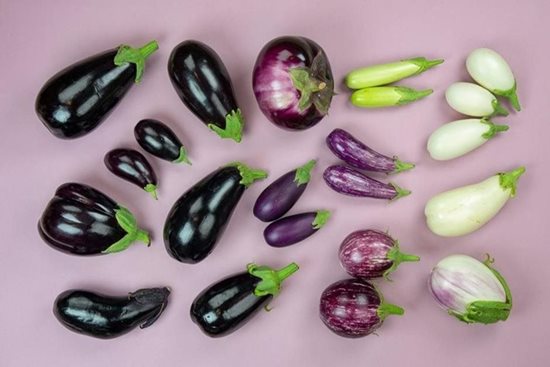The Aubergine: A Versatile and Nutritious Vegetable
Aubergines, also known as eggplants, are a highly versatile and nutritious vegetable that is enjoyed by people all over the world. With their unique flavor and texture, aubergines have become a staple ingredient in various cuisines. Whether roasted, grilled, or used in stews and curries, aubergines add depth and richness to dishes. Not only are they delicious, but they also offer an array of health benefits. From their rich vitamin and mineral content to their antioxidant properties, aubergines are a valuable addition to any diet.
Historical Background
Aubergines have a fascinating history that dates back thousands of years. Originating in India, they were first cultivated in China around 500 BC. From there, aubergines spread to the Middle East, Africa, and eventually Europe. In each region, aubergines were embraced and incorporated into local cuisines, becoming an integral part of traditional dishes.
Throughout history, aubergines have held cultural significance in many societies. In ancient Persia, for example, aubergines were believed to have aphrodisiac properties. In Mediterranean countries, aubergines were considered a symbol of fertility and were often included in wedding feasts. Today, aubergines continue to be celebrated for their culinary versatility and cultural importance.
Nutritional Value of Aubergines
Aubergines are not only delicious but also highly nutritious. They are low in calories and fat, making them an excellent choice for those looking to maintain a healthy weight. Aubergines are also a good source of dietary fiber, which aids in digestion and promotes a feeling of fullness.
Additionally, aubergines are packed with essential vitamins and minerals. They are a rich source of vitamin C, which supports the immune system and promotes collagen production. Aubergines also contain vitamin K, which plays a vital role in blood clotting and bone health.
Furthermore, aubergines are loaded with antioxidants, including nasunin, chlorogenic acid, and anthocyanins. These antioxidants help protect the body against free radicals and oxidative stress, reducing the risk of chronic diseases such as heart disease and certain types of cancer.
Aubergines in Cooking
Aubergines are incredibly versatile in the kitchen and can be prepared using various cooking methods. One popular technique is roasting, which brings out the natural sweetness and enhances the flavor of the vegetable. To roast aubergines, simply slice them into thick rounds, brush with olive oil, sprinkle with salt and pepper, and bake in the oven until tender and golden brown.
Grilling is another fantastic way to cook aubergines. The high heat caramelizes the sugars in the vegetable, resulting in a smoky and charred flavor. To grill aubergines, cut them into thick slices or lengthwise halves, brush with oil, and grill until they are soft and marked with grill lines.
Aubergines are also commonly used in stews, curries, and stir-fries. They absorb the flavors of the other ingredients and add a rich and creamy texture to the dishes. For example, in a classic ratatouille, aubergines are combined with tomatoes, peppers, and zucchini to create a flavorful vegetable medley.
Here are a few popular recipes from different cuisines that showcase the versatility of aubergines:
- Moussaka: A Greek dish that layers roasted aubergines with ground meat, tomatoes, and béchamel sauce.
- Baba Ganoush: A Middle Eastern dip made from roasted aubergines, tahini, garlic, lemon juice, and olive oil.
- Baingan Bharta: An Indian dish where roasted aubergines are mashed and cooked with tomatoes, onions, and spices.
- Parmigiana di Melanzane: An Italian dish that combines breaded and fried aubergines with tomato sauce, mozzarella, and Parmesan cheese.
Whether you prefer them roasted, grilled, or incorporated into a variety of dishes, aubergines offer endless possibilities in the kitchen.

Aubergines in Different Cultures
Aubergines have found their way into the culinary traditions of numerous cultures around the world. In Mediterranean cuisine, aubergines are a staple ingredient in dishes such as moussaka, ratatouille, and caponata. These dishes showcase the region’s love for combining aubergines with other fresh vegetables and aromatic herbs.
In Middle Eastern cuisine, aubergines are widely used in dishes like baba ganoush, a creamy and smoky eggplant dip, and maqlooba, a flavorful one-pot rice dish layered with aubergines, meat, and vegetables. Aubergines are also a key component of Turkish cuisine, where they are often stuffed with rice, meat, or a mixture of vegetables and herbs.
In Asian cuisines, aubergines play a significant role as well. In China, they are used in dishes like Sichuan-style eggplant stir-fry and braised eggplant with garlic sauce. In India, aubergines are featured in curries, such as baingan bharta and aloo baingan, where they are combined with spices and other vegetables.
Each culture brings its unique twist to aubergine dishes, showcasing the vegetable’s adaptability and ability to harmonize with different flavors and cooking techniques.
Common Varieties of Aubergines
Aubergines come in a variety of shapes, sizes, and colors, each with its own distinct flavor profile and culinary uses. Here are some common varieties:
- Globe Aubergines: The most common variety, these have a rounded shape and deep purple skin. They have a mild and slightly bitter taste.
- Italian Aubergines: These are smaller and elongated with dark purple skin. They have a creamier texture and are often used in Italian dishes like parmigiana.
- Japanese Aubergines: Also known as “Ichiban” or “Slim Jim,” these are long and slender with glossy purple skin. They have a delicate and sweet flavor.
- White Aubergines: These aubergines have a pale ivory or white skin and a milder flavor compared to their purple counterparts. They are often used in Asian cuisines.
- Indian Aubergines: These small-sized aubergines come in various colors, including greenand purple. They are commonly used in Indian curries and pickles.
- Thai Aubergines: These small, round aubergines come in different colors, including green, yellow, and white. They are known for their slightly bitter taste and are often used in Thai curries and stir-fries.
Each variety of aubergine brings its own unique flavor and texture to dishes, allowing for a diverse range of culinary creations.
Growing and Harvesting Aubergines
If you’re interested in growing your own aubergines, they can be successfully cultivated in home gardens or small-scale farming. Here are some steps to guide you:
- Choose the right location: Aubergines thrive in warm climates with plenty of sunlight. Select a spot in your garden that receives at least 6-8 hours of direct sunlight each day.
- Prepare the soil: Aubergines prefer well-draining soil with a pH level between 6.0 and 7.0. Add organic matter, such as compost or aged manure, to improve soil fertility and drainage.
- Sow the seeds or transplant seedlings: Start aubergine seeds indoors 8-10 weeks before the last frost date, or purchase seedlings from a nursery. Transplant the seedlings into the garden once the soil has warmed up.
- Provide proper care: Water the plants regularly, keeping the soil evenly moist but not waterlogged. Mulch around the plants to conserve moisture and prevent weed growth. Fertilize with a balanced organic fertilizer every 4-6 weeks.
- Support the plants: As the aubergine plants grow, they may require support to prevent the heavy fruits from weighing down the branches. Use stakes or cages to provide support and keep the plants upright.
- Harvesting: Aubergines are ready to harvest when they reach their mature size and have a glossy skin. Cut the fruits off the plant using a sharp knife or pruning shears, leaving a short stem attached.
By following these guidelines and providing proper care, you can enjoy a bountiful harvest of fresh and flavorful aubergines from your own garden.
FAQs
What are the different names for aubergines in different countries?
Aubergines are known by various names around the world. In the United States and Canada, they are commonly referred to as eggplants. In the United Kingdom and Australia, they are known as aubergines. Other names include brinjal (South Asia and South Africa), melanzane (Italy), berenjena (Spain and Latin America), and nasu (Japan).
How do I select a ripe and fresh aubergine at the grocery store?
When choosing aubergines, look for ones that have smooth, shiny skin and feel heavy for their size. Avoid aubergines with wrinkled or discolored skin, as these may indicate that the vegetable is past its prime. The stem should be green and fresh-looking. Press the flesh gently with your finger it should give slightly but bounce back. This indicates that the aubergine is ripe and ready to be used.
Can aubergines be eaten raw, or do they require cooking?
Aubergines are typically cooked before consuming. While they can be eaten raw, they have a slightly bitter taste and a tough texture. Cooking aubergines helps to soften their flesh, enhance their flavor, and improve their overall texture. Whether roasted, grilled, or sautéed, cooking aubergines brings out their natural sweetness and makes them more enjoyable to eat.
Are aubergines suitable for individuals with specific dietary restrictions, such as gluten-free or vegan diets?
Aubergines are naturally gluten-free, making them a suitable choice for individuals following a gluten-free diet. They are also vegan-friendly and can be incorporated into a variety of plant-based dishes. Aubergines can be used as a meat substitute in vegetarian and vegan recipes due to their meaty texture and ability to absorb flavors.
What are some common substitutes for aubergines in recipes?
If you’re looking for a substitute for aubergines in a recipe, zucchini or bell peppers can be used as alternatives. Both vegetables have a similar texture and can provide a similar taste and visual appeal in dishes. However, keep in mind that the flavor profile may differ slightly, so adjust seasonings accordingly.
How can I store leftover aubergines to maintain their freshness?
To store leftover aubergines, place them in a perforated plastic bag or wrap them in a paper towel to absorb excess moisture. Store them in the refrigerator’s crisper drawer, where they will stay fresh for up to five days. Avoid washing the aubergines before storing them, as moisture can accelerate spoilage.
Are there any potential allergic reactions or side effects associated with consuming aubergines?
Aubergines are generally safe for consumption and do not commonly cause allergies. However, some individuals may be sensitive to nightshade vegetables, which include aubergines, tomatoes, and peppers. If you have a known allergy or sensitivity to nightshade vegetables, it is best to avoid consuming aubergines.
Can aubergines be frozen for long-term storage?
Yes, aubergines can be frozen for long-term storage. To freeze aubergines, first, wash and slice them into desired shapes. Blanch the slices in boiling water for a couple of minutes, then transfer them to an ice bath to cool. Once cooled, pat them dry and place them in freezer-safe bags or containers. Frozen aubergines can be stored for up to 8-10 months. Thaw them before using in recipes.
What are some creative ways to incorporate aubergines into everyday meals?
There are numerous creative ways to use aubergines in everyday meals. You can make a delicious eggplant lasagna by replacing traditional noodles with thinly sliced aubergines. Another idea is to stuff aubergines with a mixture of quinoa, vegetables, and herbs, then bake them for a flavorful and nutritious meal. Aubergine slices can also be used as a base for mini pizzas, topped with tomato sauce, cheese, and your favorite toppings.
Are there any traditional medicinal uses of aubergines?
While aubergines are primarily valued for their culinary uses, they have been used in traditional medicine in some cultures. In Ayurvedic medicine, aubergines are believed to have detoxifying properties and are used to treat digestive disordersand promote overall gut health. They are also thought to have anti-inflammatory properties and may be used to alleviate symptoms of arthritis and other inflammatory conditions. However, it’s important to note that scientific research is limited in this area, and it’s always best to consult with a healthcare professional before using aubergines or any other food as a form of treatment.
Conclusion
Aubergines, with their versatility, nutritional value, and rich history, are truly a remarkable vegetable. From their origins in India to their widespread popularity in cuisines around the world, aubergines have captured the hearts and taste buds of many. Their unique flavor, ability to absorb and enhance other flavors, and numerous health benefits make them a valuable addition to any kitchen.
Whether you enjoy them roasted, grilled, or incorporated into a variety of dishes, aubergines offer endless possibilities for culinary exploration. Their cultural significance and traditional uses in different countries further highlight their importance in global cuisine.
So why not embark on a culinary adventure and discover the wonders of the aubergine? Whether you’re a seasoned chef or a beginner in the kitchen, there’s no doubt that aubergines will add depth, flavor, and nutrition to your meals. So go ahead, embrace the versatility of the aubergine and let it inspire your culinary creations.




